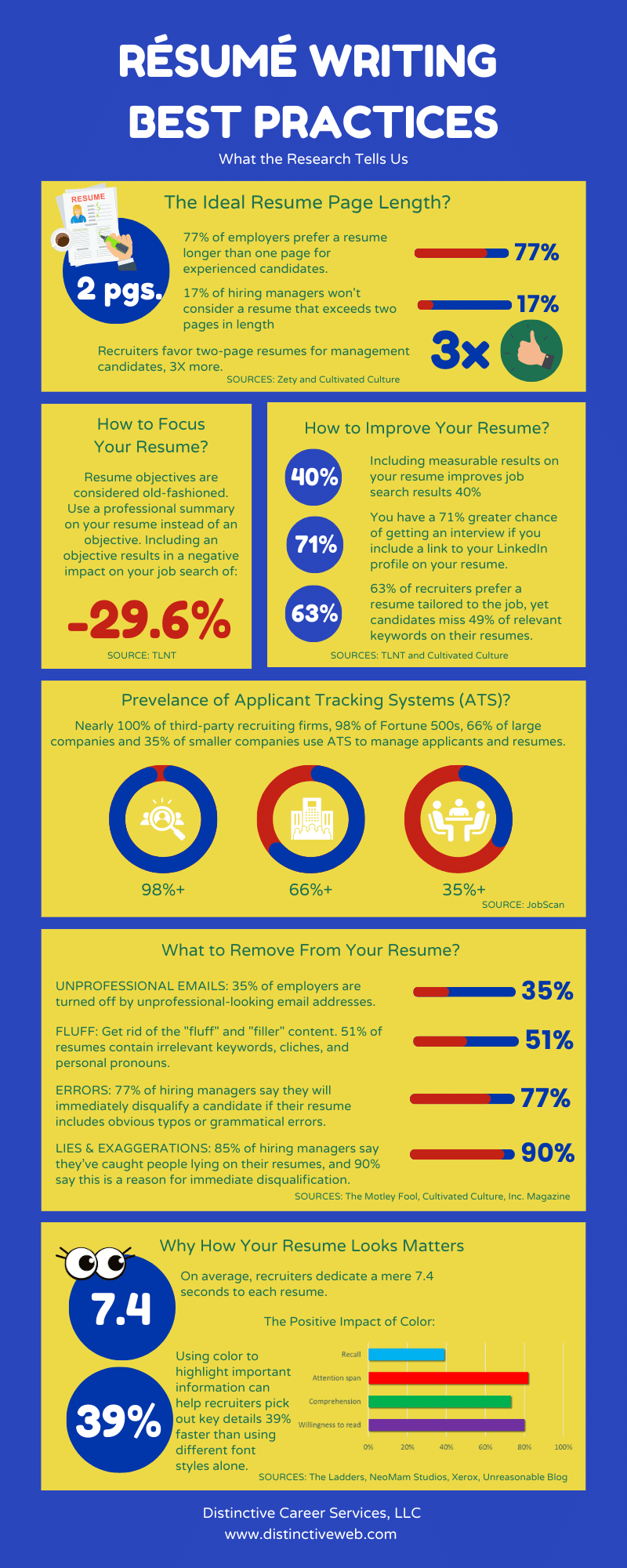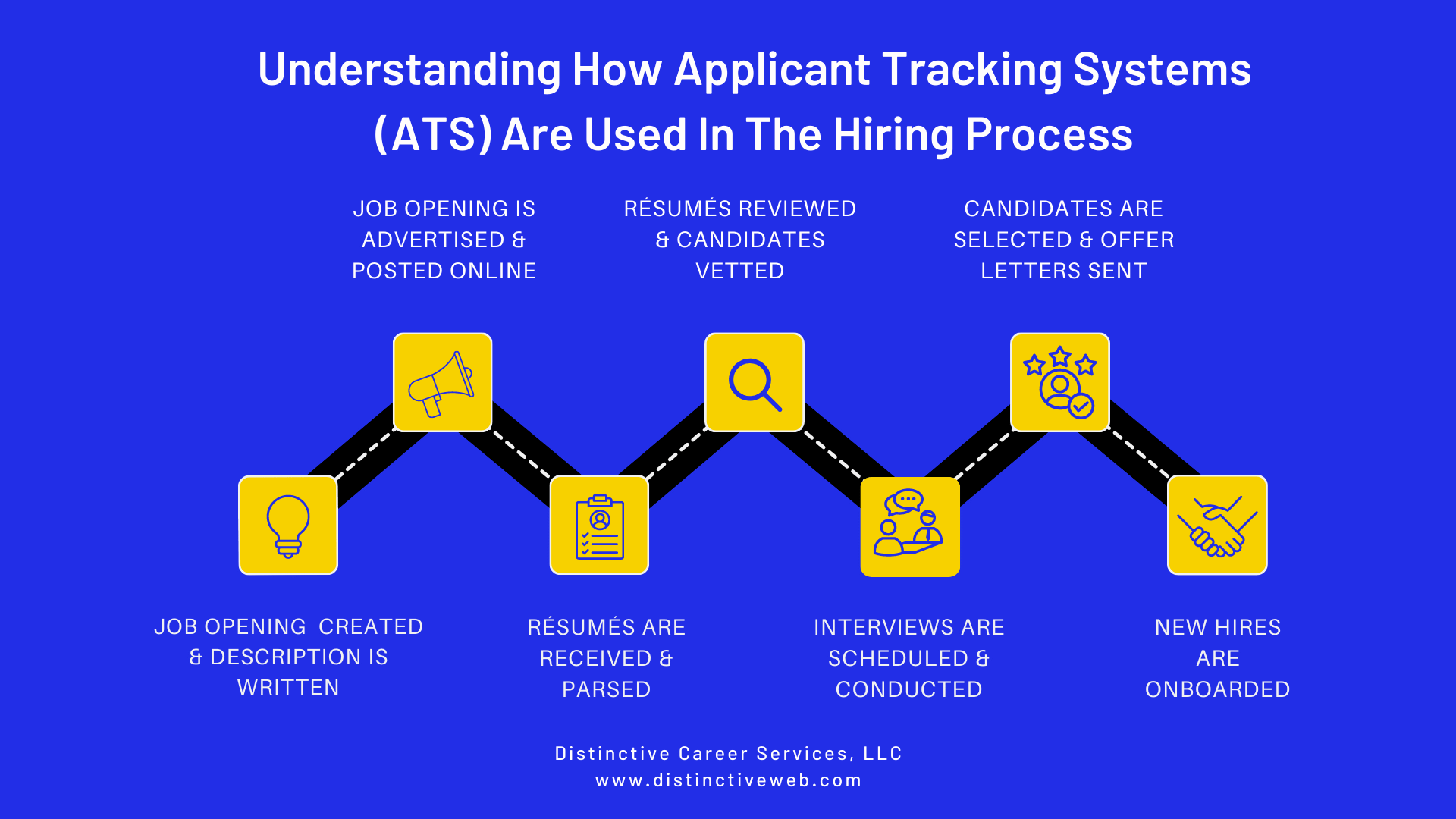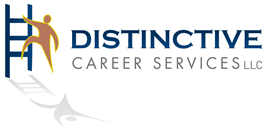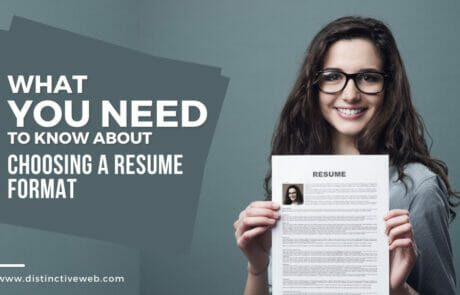
Picture this: you’re in a race, but it’s not just any race. It’s a race where the track keeps changing, the rules keep evolving, and the finish line keeps moving.
 That’s what today’s job market feels like. Your resume is your running shoes in this race—it’s got to keep up, stand out, and, most importantly, it’s got to fit just right.
That’s what today’s job market feels like. Your resume is your running shoes in this race—it’s got to keep up, stand out, and, most importantly, it’s got to fit just right.
Navigating the ever-changing landscape of resume writing best practices can feel daunting. The modern trends shift, the technologies advance, and what worked yesterday might not work tomorrow. But here’s the good news: you’re not alone in this.
As experts in resume writing, we work with thousands of job seekers every year. Staying up-to-date on the latest resume writing trends and best practices isn’t just important to us—it’s essential. It’s the cornerstone of our work and how we ensure that our clients have the best possible chance of landing their dream jobs.
In this article, we’re sharing this knowledge with you. We’ve distilled our expertise and the latest resume writing research into a comprehensive guide to resume writing best practices. Whether you’re a seasoned professional updating your executive resume or a fresh graduate crafting your first one, you will find helpful advice here.
TABLE OF CONTENTS:
- Stand Out & Get Hired: Research-Based Resume Writing Best Practices
- Choosing Your Path: Best Resume Format Tips
- Navigating from Resume Objectives to Resume Summaries
- Tailoring Your Resume to Each Job Description: Mapping Your Journey to the Employer’s Needs
- Taking Your Resume to the Next Level: A Journey Beyond the Basics
- Advanced Resume Tips: Charting Your Course to Success
- Creating a Professional and Visually Appealing Layout: The Power of First Impressions
- Incorporating Digital Elements: Enhancing Your Resume’s Online Footprint
- Embarking on Your Career Journey: The Power of an Exceptional Resume
- Frequently Asked Questions
- What is a resume?
- Why is it important to customize your resume for each job?
- How long should my resume be?
- What should I include in my resume?
- How can I make my resume stand out to employers?
- Should I include a photo on my resume?
- What is a resume summary and should I include one?
- How often should I update my resume?
Choosing Your Path: Best Resume Format Tips
Just as every journey requires the right path to reach the destination, your job search journey needs the right resume format to land the ideal job. The resume format you choose can significantly impact how recruiters perceive your application. It can highlight your strengths, downplay weaknesses, and make your resume more appealing. However, it’s crucial to understand that different formats are suited to different career backgrounds and objectives.
Chronological Resume: The Straight Path
The chronological resume format is like a straight path. It lists your work experience in reverse order, starting with your most recent job. This simple format is ideal for those with a strong, consistent work history and linear career progression. However, a pure reverse-chronological resume is rarely used anymore, as it can make it harder to highlight specific skills and achievements.
Functional Resume: The Scenic Route
The functional resume format is like taking the scenic route. It emphasizes your skills and abilities over your chronological work history.
This format can benefit those with gaps in their employment, career changers, or those new to the workforce.
On the downside, while this format can be helpful in some specific situations, recruiters often view it skeptically. It can raise red flags, making the candidate appear to be trying to hide something. A functional resume can also cause compatibility problems with applicant-tracking software, and if your resume doesn’t make it into these systems, a human hiring manager may never even see it.
Combination Resume: The Guided Tour
The combination or hybrid format is like a guided tour. It merges the best of both worlds. It integrates elements of both the chronological and functional formats, allowing you to showcase your skills and abilities while also providing a detailed work history.
This format is the most common and recommended for most job seekers. It eliminates the problems associated with the other two formats, offering a balanced approach that appeals to recruiters.

The reality is recruiters often have only a fleeting moment to review each resume. Studies indicate that 40% of hiring managers confess to spending less than a minute on each resume, with a quarter admitting to spending less than half a minute. However, an eye-tracking study revealed a more startling fact: on average, recruiters dedicate a mere 7.4 seconds to each resume. This is one key reason why the combination format is ideal—it makes the resume easy to read and to scan quickly to come away with key points.
Here are some resume best practice tips to help you choose the right format:
Remember, the goal is to make your resume stand out, showcasing your skills, experiences, and career trajectory to the hiring manager. Choose the format or resume template that allows you to present these elements in the most compelling way.
Navigating from Resume Objectives to Resume Summaries
Just as a journey unfolds and changes over time, so do resume trends. The path of writing the perfect resume has seen many shifts, and one of the most significant has been the transition from resume objectives to resume summaries.
The Old Path: Resume Objectives
In the past, writing a resume often began with an objective statement. This was a brief declaration of your career goals, essentially telling employers what you were looking for.
However, like a road that’s fallen into disrepair, the resume objective has lost its appeal. In fact, research shows that using an objective on your resume can have a negative impact of 29.6% on your chances of landing an interview.
The reason? Employers are more interested in what you can offer them, not what you want from them.
The New Route: Resume Summaries
The modern resume trend, and the path most likely to lead to success, is to start your resume with a professional summary. This is a concise, compelling overview of your skills, experiences, and accomplishments most relevant to the position you’re applying for. It’s like a roadmap that quickly shows employers where you’ve been, what you’ve achieved, and how your journey aligns with the role they’re looking to fill.
You may choose a paragraph structure for your summary or use a series of bullet points. In either case, a well-crafted resume summary can:
As you embark on your journey to a perfect resume, remember that the goal is to write a resume that reflects not only where you’ve been but also where you’re headed. A resume summary statement, unlike an objective, does just that. It’s a powerful tool that can help guide you to your destination: a successful job interview.

Tailoring Your Resume to Each Job Description: Mapping Your Journey to the Employer’s Needs
You should craft your resume to align with the unique requirements of each job description. A significant 63% of recruiters favor a resume that’s customized to the specific job requirements. However, a surprising 54% of job applicants overlook this crucial step, missing an opportunity to make their resume resonate with potential hiring managers.
Understanding the Job: Charting Your Course
The first step in this process is akin to charting your course on a map. You need to understand the job posting thoroughly. This means identifying the critical skills, experiences, and qualifications the hiring manager is seeking. It’s about understanding the terrain you’re about to navigate and planning your journey accordingly.
Highlighting Relevant Skills and Experiences: Packing the Right Gear

Once you’ve charted your course, the next step is to pack the right gear for your journey. In resume terms, this means ensuring the most relevant skills and experiences you possess are prominent and easy to find in your resume and that irrelevant information has been removed. You may even choose to include a separate skills section in your resume.
Just as you wouldn’t embark on a mountain hike without the proper equipment yet wouldn’t carry anything you don’t need, you shouldn’t apply for a job without showcasing key aspects of your background that make you the right fit. Similarly, unnecessary equipment would weigh you down. For the same reason, you should include only relevant information on your resume.
Genuinely understanding the resume tips regarding relevant and irrelevant information will guide you when you wonder whether to include or exclude something from your resume. For example, if volunteer work is substantial and relevant to your desired job, you may include it. However, you should exclude personal information such as marital status, age, and unrelated hobbies.
Using the Same Language: Speaking the Local Dialect
If the job description uses specific terminology or industry jargon, mirror these keywords in your resume. This shows that you understand the industry and helps your resume score well in the applicant tracking software. It’s like speaking the local dialect on your journey—it enables you to connect with the locals (or, in this case, the recruiters) and navigate your way more effectively.
The language you use can significantly influence the impression you make on recruiters in other ways too. It’s akin to the dialect you use on your journey—it can either help you connect with the locals or create unnecessary barriers. Here are some best resume practices to ensure your content is as effective as possible:
Remember, each job application is a unique journey, and your resume is your map. By tailoring and targeting your resume to each job description, you’re making your journey more targeted and effective and significantly increasing your chances of reaching your destination: landing the job interview.
[cp_popup display=”inline” style_id=”20659″ step_id = “1”][/cp_popup]
Taking Your Resume to the Next Level: A Journey Beyond the Basics
In the journey of crafting your resume, understanding the basics is akin to packing the essentials for a long trip. However, to truly make your journey successful and memorable, you must go beyond the basics.
This next section will guide you through the advanced resume writing best practices and tips that can take your resume to the next level, ensuring you stand out in the competitive job market.
The Power of Action Verbs and Quantifiable Achievements
Action verbs and quantifiable achievements guide recruiters through your professional journey. They provide clear and compelling evidence of your skills and accomplishments, making your resume more engaging and persuasive.
Past tense action verbs, such as ‘spearheaded,’ ‘strengthened,’ ‘designed,’ or ‘navigated,’ add dynamism to your resume, making your experiences and achievements more vivid and impactful. In fact, there is evidence using dynamic verbs in your resume can improve your chances of getting an interview up to 140% because they show recruiters not just what you did but how you did it, giving them a clearer picture of your capabilities.
Quantified achievements provide even more concrete evidence of your skills and abilities. Unfortunately, a shocking 36% of resumes don’t include any quantified results.
Why are quantifiable achievements in your resume so impactful? Simple. They show the potential employer the tangible results of your work, making your accomplishments more credible and convincing. For example, instead of saying you ‘improved sales,’ you could say you ‘increased sales by 20% in six months’.
This gives hiring managers a clear measure of your success and the ROI they can expect from hiring you. Knowing this, it isn’t surprising that research has suggested that including measurable results on your resume can improve your job search results 40%. Many of the best resume templates acknowledge the importance of accomplishments on your resume and use bullet points to call attention to them.

The Importance of an Applicant Tracking System (ATS) Friendly Format
In the job hunting journey, an Applicant Tracking System (ATS) can be seen as a checkpoint you must pass to reach your destination.
ATS is a software tool employed by an overwhelming majority of companies, including nearly 100% of third-party recruiting firms and approximately 98% of Fortune 500 companies. Even smaller businesses are increasingly adopting this technology.
These systems function as ‘gatekeepers,’ managing the influx of applicants and their resumes throughout the hiring process. They filter and rank resumes, making them an essential hurdle you must clear in your job search.
While the idea of these seemingly impersonal ‘gatekeepers’ might cause some unease, it’s worth noting that an impressive 94% of recruiters find that ATS has positively impacted their hiring process. Therefore, these ‘gatekeepers’ are here to stay, and learning to navigate this terrain is crucial.
To ensure your resume successfully traverses this pass, it must be in an ATS-friendly format. This involves avoiding elements like complex tables that the ATS may struggle to interpret and sticking to standard section headings such as ‘Professional Experience’ and ‘Education.’
It also involves strategically incorporating relevant information and keywords from the job ad into your resume, as these are the signposts the ATS uses to navigate your document.
Adopting an ATS-friendly format increases the likelihood of your resume making it past this digital gatekeeper and landing on the recruiter’s desk. Here are some tips to help you master this terrain:
The Role of Keywords in Optimizing Your Resume for ATS
We’ve already mentioned this, but it bears repeating. Just as a seasoned explorer uses a map to navigate unfamiliar terrain, keywords guide the ATS through the landscape of your resume. They help the system decode the content of your resume and determine its relevance to the job.
To optimize your resume for ATS, you need to become a skilled cartographer of your own professional journey. This involves identifying the landmarks (keywords) in the job description and marking them prominently on your map (resume). These landmarks could be specific skills, qualifications, or experiences the employer seeks.
However, using these keywords naturally and in context is crucial, just as landmarks appear naturally along a route. Overstuffing your resume with keywords, or ‘keyword stuffing,’ can be as detrimental as a cluttered, unreadable map.
Interestingly, research shows that, on average, candidates miss 49% of relevant keywords on their resumes when applying for a position. This is akin to missing half the landmarks on your map, making your journey unnecessarily challenging. Ensuring your resume is rich with the right keywords can be a game-changer in reaching your desired destination: landing the role you want.
Here’s how to optimize your resume with keywords:

By using keywords effectively, you can create a map that guides the ATS through your resume and leads you straight to the interview stage of your job-hunting journey.
The Value of Emphasizing Transferable Skills
In the journey of career progression, transferable skills are a universal currency you can use in any new job or industry. You can apply these skills in various contexts, such as communication, problem-solving, or leadership.
Emphasizing these skills in your resume can show recruiters your versatility and adaptability, making you a more attractive candidate. It can also help you stand out from other candidates who may have more specific but less transferable skills.
The Balance Between Being Succinct and Comprehensive
The length and organization of your resume can significantly influence its effectiveness. It’s a delicate balancing act between being concise and comprehensive. The sweet spot for a resume length is between 475 and 600 words, roughly equivalent to two pages. However, 77% of resumes fall short of this ideal length. The average resume length is around 489 words, with the median length slightly shorter at 369 words. Here are some tips:
In essence, crafting a resume is about striking the right balance. It should be long enough to showcase your skills and experiences comprehensively but concise enough to maintain the reader’s interest and ease of reading.
Advanced Resume Tips: Charting Your Course to Success
As we approach the end of our journey, it’s time to delve into the advanced strategies that can elevate your resume from good to exceptional.
These strategies are like the hidden trails experienced travelers use to reach their destinations more efficiently and enjoyably. They can help you showcase your unique value proposition, tell a compelling story, and stay ahead of trends in best practices when crafting a great resume.
Leveraging the Power of Resume Storytelling
Storytelling is like the narrative thread that weaves your professional background and experiences into a compelling story. It’s not just about listing your skills and experiences; it’s about connecting the dots in a way that tells a coherent and engaging story about your professional journey.
To leverage the power of storytelling in your resume, focus on the ‘so what?’ of your experiences. Don’t just say what you did; explain why it mattered, what impact it had, and what it says about you as a professional. Here are some more resume tips:
Creating a Professional and Visually Appealing Layout: The Power of First Impressions
Just as a traveler appreciates the beauty of a well-designed map, recruiters appreciate a resume with a visually appealing layout. In fact, the visual aspect of your resume can significantly influence a recruiter’s first impression of you. Studies suggest that within the first 15 seconds of meeting someone, people form their first impression, and approximately 70% of their impression is based on appearance. The same principle applies to your resume—it’s your professional packaging, and attractive packaging helps sell.
Consider this: almost half of our brain is dedicated to processing visual information. We are hardwired to respond to visuals, registering them up to 60,000 times faster than text. Moreover, visuals enhance our ability to learn by a staggering 400%, and we remember 80% of what we see compared to only 20% of what we read.
So, how can you leverage these insights to create a visually appealing resume layout? Here are some strategies:
By creating a professional and visually appealing resume layout, you can ensure your resume stands out from the pile, grabs the recruiter’s attention, and leaves a lasting impression. After all, a visually appealing layout can make all the difference in the average 7.4 seconds that a recruiter spends reviewing each resume. You can review more example resume designs in our portfolio.

Incorporating Digital Elements: Enhancing Your Resume’s Online Footprint
Your online presence can significantly influence your job prospects in the digital age. In fact, resumes that include a link to a LinkedIn profile are 71% more likely to land an interview. However, surprisingly, less than half of all resumes take advantage of this opportunity. Here are some strategies to effectively incorporate digital elements into your resume:
Incorporating these digital elements into your resume can enhance your online footprint, providing recruiters with a richer, more holistic picture of your professional capabilities. This can significantly increase your chances of progressing to the interview stage of the hiring process.
Staying Current with Industry Trends and Leveraging AI
Just like a seasoned traveler stays up-to-date with the latest travel trends and technologies, a savvy job seeker stays abreast of the latest trends in resume writing and leverages the power of AI.
AI is increasingly used in recruitment, from AI-powered job matching to automated resume screening. Understanding how these technologies work and how to optimize your resume for them can give you a competitive edge.
For example, many companies use Applicant Tracking Systems (ATS) to screen resumes. These systems use AI to scan resumes for keywords and rank them based on their relevance to the job description. By understanding how ATS works and optimizing your resume accordingly, you can increase your chances of getting past this initial screening and landing an interview.
Embarking on Your Career Journey: The Power of an Exceptional Resume
Embarking on the path to crafting an exceptional and effective resume is a journey, not a mere destination. It’s an ongoing process of learning, adapting, and refining. By embracing these resume writing best practices, you’re not just ensuring your application propels you to the interview stage, but you’re also laying the groundwork for success in your future career journey.
Remember, the journey of a thousand miles begins with a single step. So, take that step today, start crafting your exceptional resume, and embark on your journey to career success. Safe travels!
Frequently Asked Questions
What is a resume?
A resume is a document that you give to employers to show your work history, skills, education, and achievements. It helps employers decide if they want to interview you for a job.
Why is it important to customize your resume for each job?
Customizing your resume for each job is important because it shows the employer that you are a good fit for that specific job. When you match your skills and experiences with what the job needs, it increases your chances of getting an interview.
How long should my resume be?
Your resume should be one or two pages long. If you are new to working, one page might be enough. If you have a lot of work experience, you might need two pages to list all your important jobs and achievements.
What should I include in my resume?
In your resume, you should include your contact information, work history, skills, education, and any special achievements or awards. It's also good to add any volunteer work or projects that relate to the job you want.
How can I make my resume stand out to employers?
To make your resume stand out, use a clean and professional format. Make sure it's easy to read by using bullet points and short sentences. Highlight your most important skills and achievements that are relevant to the job.
Should I include a photo on my resume?
You usually should not include a photo on your resume. In many places, employers prefer not to see a photo to make sure they are fair in deciding who to interview based on skills and experience only.
What is a resume summary and should I include one?
A resume summary is a short section at the beginning of your resume that tells employers quickly about your most important skills and experiences. It's a good idea to include one if you can clearly say how you can help the company based on your background.
How often should I update my resume?
It's a good idea to update your resume every time you gain a new skill, complete a significant project, or change jobs. This keeps your resume fresh and ready whenever new job opportunities come up.









